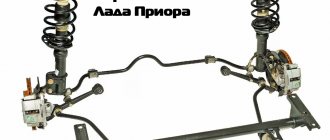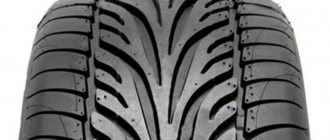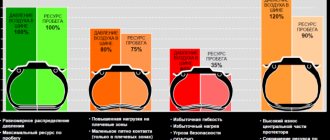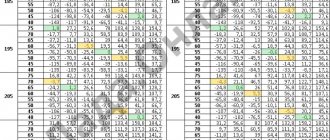Which car is more prestigious
The latest trends in the field of domestic automotive fashion emphasize that Vesta is endowed with a much more advantageous appearance, and its popularity is fueled by a well-promoted advertising campaign. Against this background, Largus looks like a “dark horse”. Before the comparative review, let’s remember who was at the origins of the domestic station wagon? It can’t be, but this is Renault Logan itself and its Romanian “derivative” - Dacia Logan MCV. Such roots are worth a lot, so in the “prestige” discipline, the absolute parity of our participants should be noted.
What to choose – Lada Largus or Lada Vesta SV, serial production model
AvtoVAZ will launch production of the LADA Largus CNG in November 2018, and serial production of the model will begin in the first quarter of 2021. The car's power reserve will be 1,055 kilometers, including 320 kilometers on gas alone. Acceleration from zero to 100 km/h will take the Largus CNG 14.5 seconds, and the maximum speed will be 155 km/h.
At the same time, due to the presence of gas equipment, the luggage compartment volume of the passenger version decreased by 110 liters, amounting to 450 liters. In the cargo version, the trunk has become smaller by 100 liters - up to 2,400 liters.
AvtoVAZ expects to assemble 3.7 thousand dual-fuel Largus cars next year.
Currently, LADA Vesta CNG is available at LADA dealers. The price of the car starts from 765 thousand rubles. In 2021, AvtoVAZ expects to produce 2,000 dual-fuel Vests. Last year, 707 LADA Vesta CNG were assembled.
Without going into numbers, Vesta is inferior to Largus in length, height, trunk volume, weight, and wheelbase. But overall the difference in size is insignificant. The ground clearance of a sedan is much higher. And if the rear sofa of the Largus trunk is folded, the differences in size are almost imperceptible.
Exterior, what is the difference between Largus and Vesta
The difference in appearance is quite noticeable, but which is better in this case, Lada Largus or Lada Vesta. Here you can safely attach the prefix “retro” to the Largus model, since against its background Vesta is positioned as a promising new product. The station wagon is endowed with calm body lines in terms of design. This is more than confirmed by the contours of the hood, head optics and front grille. If you look at the profile of this car, the viewer is visited by sadness and despondency, because the simplicity of the design is not capable of concealing zest. The station wagon's stern delivers a similar sensation. Here is a long-boring narrow bumper, the contours of which are repeated by the lines of stretched brake lights. The large glass area does not border on a sporty appearance.
If we compare, Vesta against this background is the complete opposite. The exterior design is replete with fashionable delights. The front of the car hints at speed and eccentricity, and the side panels will delight you with the modern trends of the now fashionable “X” style, which is echoed by the presence of the corresponding form of stampings. The front part is especially chic thanks to the grille, which blends smoothly with the intakes for oncoming air flow. The anti-fog optics have a distinctive style, as if emphasizing a hint of solidity. Let's continue the comparison.
What to choose - Lada Largus or Lada Vesta SV, AvtoVAZ statement
True, the bias towards aesthetics made the Vesta SW by no means the most practical car in the segment. Significant unification with the sedan did not help this either. Although AvtoVAZ claims to have developed 39 new body parts, the components that determine the dimensions of the interior are the same for the sedan and station wagon. The rear of the five-door is reinforced, but the size of the trunk under the shelf is identical to that of the sedan - 480 liters (more will fit under the ceiling, of course). But in the middle and top trim levels, the station wagon has a six-section organizer under the floor with a volume of about 100 liters, into which you can store rarely used small things: a cable, a warning triangle, gloves.
Unification with the sedan led to a number of other limitations, for example, the trunk has a high threshold, and the seats do not fold into a flat floor.
With the same wheelbase size, the spaciousness of the rear seats in both cars is the same in length, but the station wagon provides +2.5 cm of air above the passengers' heads - this is a plus. As for the longitudinal dimensions, the model was already one of the segment leaders in terms of this parameter.
However, the Lada Vesta SW has not become the most practical car in the B+ segment: the utilitarian Lada Largus station wagon is significantly larger, the Skoda Rapid liftback also has a larger trunk. AvtoVAZ doesn’t see this as a problem: they say the Vesta SW station wagon is addressed to those who want a mostly civilian car, but sometimes need a large opening in the cargo compartment, for example, to carry bicycles or oversized cargo. An Izhevsk car should attract first of all with its combination of practicality and design, and from this angle the Vesta SW is truly convincing.
AvtoVAZ plans to expand the model range of dual-fuel Ladas. Nowadays, car enthusiasts have access to the LADA Vesta CNG, which runs on both gasoline and compressed natural gas. In 2021-2019, LADA Largus CNG will go on sale, and in 2021 – LADA Granta CNG, Autostat reports.
Interior of Lada models
The interiors of these Lada Largus or Lada Vesta cars are also incommensurable. If Vesta’s interior will please you with its laconicism, originality and genuine attractiveness, then Largus can provide the owner with a straightforward and discreet design of most interior components. There is no need to argue about the convenience and practicality of this interior, since these qualities are at their best. It is simply devoid of bright and memorable notes.
If you compare, the interior of the Vesta features a comfortable steering rim, well-profiled seats and an elegant instrument panel, in which bright lighting instills harmony with the space.
Interior
Comparing the interior style is completely pointless. As much as the Lada Vesta is bright and attractive inside, the Largus is boring and simple.
Vesta confirms its status as a modern car. The transitions and lines in the dashboard are made in the best traditions, high-quality finishing materials, a comfortable steering wheel, moderately dense and well-profiled seats, a spacious back row, an armrest, well-chosen colors, impressive wells in the dashboard, poisonous lighting, etc.
The interior of the Lada Vesta is original and attractive - there is nothing to reproach it with.
In contrast to Vesta, the station wagon simply has nothing to demonstrate. The dull design of the interior, with its straight lines, surprisingly unnatural metal-look inserts on the budget black plastic of the dashboard and steering wheel, tasteless nozzles for air deflectors, simple instrument dials - the same old Logan, but in a new body. However, the ergonomics are not bad, although some of the controls are blocked by the gearshift lever, and I would like the lateral support of the seats to be more developed. And the orange backlight breaks up the monotony a little.
This is not to say that the interior of the Lada Largus is bad. He's just expressionless.
In general, the Largus interior is quite comfortable, but extremely boring, and after Vesta, being surrounded by such “luxury” is simply unbearable.
Engines in Lada Vesta and Lada Largus cars
The power of the engine used in the fashionable Vesta is higher in comparison with the output of both variants of power units addressed by the manufacturer to the practical Largus station wagon. If a sedan is capable of demonstrating dynamics at the level of 11.8 seconds to the first “hundred”, and the maximum speed indicator reaches 178 km per hour, then for a station wagon these characteristics are unattainable, since its dynamics are 14.2 seconds and the speed limit is 158 km per hour. hour.
If you notice the level of fuel consumption, then the new product will also be lower. With such positive characteristics, it is difficult to decide which is better from the Lada Largus or Lada Vesta models.
Lada vesta or lada largus: comparison of cars and which is better – Website about
Some may find it not entirely correct to compare such mutually dissimilar Russian models: Lada Largus or Lada Vesta. For these cars, the manufacturer has provided for the presence of different market segments, but we will still try to perform a comparative review.
Comparison of Lada Vesta and Lada Largus
Comparison of Lada Vesta and Lada Largus Comparison of engines
The new product from AvtoVAZ has already gained sufficient popularity. She is capable of trying to lure buyers of models that occupy a completely different niche in the market.
Trying to understand which is better than Lada Vesta or Lada Largus, corresponding comparisons of appearance, dynamics and interior were made.
The comparison may not look correct, but since the models are produced by the same representative, there is sufficient reason to compare them. "What to choose?" – this question is quite appropriate for car enthusiasts.
Transmission options in Lada models
We continue the comparison to understand which is better among the domestic cars LADA Largus or LADA Vesta. The Largus equipment in this part looks modest, because this model only has a five-speed manual transmission.
If we compare, for Vesta the manufacturer was not greedy and provided two “mechanics” options, as well as a progressive “AMT” robot. Let us remind you that both versions of mechanical units are reliable and have a similar arsenal of five stages. Here we see the fact that VAZ designers abandoned the classic “automatic” in favor of a “robot”. Time will tell how true this is.
Lada Vesta or Lada Largus: comparison of cars and which is better
Sooner or later that happy day comes when you need to go to a car dealership to buy a new car.
And since the market is replete with a wide variety of brands and models, making the right choice is sometimes not so easy. After all, you need to take into account not only the price and appearance, but also practicality, operating conditions, comfort, and technical characteristics. If we talk about the budget class, the most popular cars on the Russian market are Lada cars. And of the models offered, two of the most popular ones can be identified - Lada Vesta and Lada Largus. To understand why they are so popular and which one is better, let’s look at each model in more detail.
Lada Vesta
The main difference between this car and its predecessors is its modern design . Bright, stylish, unique, always attracts attention. Both externally and internally the car looks no worse than its foreign counterparts.
The chassis has also undergone changes. The car is very pleasant to drive. It copes well with sharp turns, is stable during sharp maneuvers, and the suspension handles bumps on the road well.
The car interior looks very nice and modern. When you sit behind the wheel for the first time, you can forget for a moment that this car is made in Russia. All interior lines are smoothed, there are no sharp corners or protrusions. The easily readable dashboard is made in a pleasant color scheme. All buttons and switches work smoothly, without annoying extraneous sounds.
The car's sound insulation has been improved. Engine sound, aerodynamic noise, tire noise - all this has become noticeably quieter, and driving over long distances is now not so tiring.
We are pleased with the variety of configurations offered. Already in the “Comfort” version there is everything necessary for a comfortable and safe ride: air conditioning, electric windows and mirrors, audio system, ABS, exchange rate stability system. More expensive trim levels add climate control, a multimedia system, and a rear view camera.
Lada Vesta is equipped with two engine options, 1.6 and 1.8 liters , as well as two transmission options - mechanical and robotic.
Among the shortcomings of the car, one can highlight the quality of materials in the cabin . For all its modernity, the interior is made of cheap plastic. The fit of the parts is not perfect. On uneven roads, extraneous squeaks may appear.
There are also complaints about the incorrect operation of the robotic transmission.
Lada Largus
Largus can rightfully be called one of the most practical cars on the Russian market. This model combines the qualities of both a good work car and a family car.
The station wagon body is very roomy and spacious. The luggage compartment is amazing in its volume, and if you fold the rear seats, the volume doubles. This allows you to transport not only personal belongings, but also construction materials, large cargo, and small furniture.
The car is also perfect for long trips. The salon is spacious and comfortable. More expensive trim levels are equipped with air conditioning, heated seats, an audio system, and electric windows and mirrors.
The design of this model, both externally and internally, is not bright and modern. But you can’t call him unattractive either. The car is made simply, concisely, without frills.
Lada Largus is presented in several trim levels, including 5 and 7 seaters. It is equipped with two versions of 1.6-liter engines: 8-valve and 16-valve, with a capacity of 87 and 106 horsepower , as well as a manual transmission.
Among the shortcomings of the car are the poor equipment in the maximum configuration and insufficient engine power. There are also comments on the ergonomics in the cabin and the quality of materials.
Car similarities
First of all, both models are in an affordable price range . In terms of price and equipment, they significantly outperform foreign competitors. Vesta and Largus handle well, are stable on the highway, and are suitable for travel. Both have suspension adapted to Russian road conditions and cope well with uneven surfaces.
Differences
Speaking about the differences, we need to start with the fact that these two cars are fundamentally different from the start. Vesta is made in a sedan , Largus in a station .
This makes a big difference in the volume of the luggage compartment. The sedan has much less volume. The body type also affects the stability of the car.
Although both models hold the road well, the station wagon is still more sensitive to strong crosswinds.
Vesta is designed for connoisseurs of comfort and style, Largus - for practicality.
The difference in engine power allows you to feel significant differences in dynamic performance. With 106 horsepower, it's hard to get playfulness in a heavy station wagon. But a sedan with a 1.8-liter engine producing 122 horsepower will pleasantly surprise fans of aggressive driving.
The interior and exterior design also have significant differences. Vesta has beauty and elegance, Largus has simplicity and conciseness.
Which car is best for whom?
The differences between vehicles determine their main application.
Lada Largus is an excellent workhorse . It is perfect for those whose work involves transporting things, small cargo, and goods. This car is indispensable for trips to the country, fishing, hunting. And by folding the rear seats, you can create an additional bed, which significantly reduces overnight costs.
Lada Vesta, thanks to its improved comfort , is perfect for both everyday trips and long-distance travel. And the luggage compartment is quite enough for the most necessary things.
It's always difficult to determine which model is better. Each of them has its own advantages and disadvantages. It is important to remember that when going to a car dealership, you first need to carefully determine the main tasks and conditions for which the car will be intended.
Source: https://vchemraznica.ru/lada-vesta-ili-lada-largus-sravnenie-avtomobilej-i-chto-luchshe/
Let's sum it up
We made a comparison, and you probably decided which of the two models is better: LADA Largus or LADA Vesta. Purchasing a Largus station wagon will be a justified action only when there is an urgent need for this particular type of body, and the competitors the client likes are located very “far” outside this price segment. In all other situations, we recommend taking a closer look at the more modern, powerful, bright and original Vesta, which rightfully won the palm in our unusual comparative review.
Summary of comparison between Vesta SW Cross and Largus Cross
When creating the Lada Largus Cross, AVTOVAZ engineers were faced with the task of maintaining the handling of the cross-version at the level of a regular station wagon. You won’t be able to notice the difference between a “raised” car and its road version on a good road. But on dirt roads or broken asphalt, the Largus Cross slightly improves in terms of ride smoothness due to the increased rolling radius of the wheel and wider tires.
Largus with the “Cross” prefix spends more gasoline than a simple station wagon. This is 1.4 liters in the city and 0.8 liters on the highway. This is due to changed gear ratios, larger wheels and an additional 35 kilograms of weight. An important nuance: the 102-horsepower sixteen-valve Largus Cross engine is designed for AI-95, and the eight-valve unit of the “regular” Largus can be powered by the 92. The difference in maintenance costs is significant.
Largus Cross costs as much as a well-equipped Vesta Cross. It has just as many options and can carry more cargo thanks to its van-shaped body. On the other hand, many will be put off by the appearance of this car and the interior, which evokes memories of the French automobile industry of the early 2000s. Vesta Cross looks more interesting in appearance, and if AVTOVAZ, as they say, worked on stable build quality, then there is only one option left in the same price category - the new Lada model.
Read also: Oil for Priora engine 16 valves
If you don't need Largus for commercial transport or you don't carry six people every day, then the choice seems pretty obvious.
LADA > Vesta
LADA > Largus
By and large, Vesta SW currently has no direct competitors in the market. Available golf station wagons from other brands are noticeably more expensive. The Lada Kalina station wagon is much more compact and cheaper. But the cost of the most stuffed Largus falls within the price range for Vesta SW. And not only in the Cross version. So let’s compare the top-end Largus in a seven-seater version and the base Vesta SW, which can be purchased for the same amount.
Lada Largus in the Luxe Prestige configuration costs 675 thousand rubles. For this money we will get a 106-horsepower engine (VAZ-21129), paired with a 5-speed manual transmission. Vesta has a similar power unit. As for the options, Largus will have a regular air conditioner at his disposal. In principle, it is not supposed to have any climate control. Only the front seats will be equipped with electric heating. It’s good that there are electric windows on all windows. The audio system is single-speaker, but with Bluetooth function. But heated windshield or cruise control are not available to the car even for an extra charge. There is no reach adjustment for the steering wheel or center box between the front seats.
As for the options, Vesta has three-stage heated front seats. There is also a heated windshield. Vesta's double-din audio system also has Bluetooth functionality. There is also cruise control with a speed limiter and a multifunction steering wheel. It turns out that Vesta offers even more for similar money. Moreover, in addition to the list of options, it has advantages that Largus does not have. We are also talking about well-thought-out ergonomics - the steering wheel is adjustable in two directions, and the seat profile and adjustments are one of the best in the class. Vesta is in no way inferior to Largus in terms of suspension energy intensity and ground clearance. At the same time, it surpasses it in controllability.
So, you can choose the top-end Largus over the basic Vesta SW only if you need a huge trunk or a seven-seater car. This is perhaps the only point where Vesta unconditionally loses. The Vesta SW station wagon went on sale recently. It is possible that in the near future the demand for Largus will decrease. But this applies exclusively to expensive trim levels of the model. The initial versions of Largus do not have the same price as Vesta. However, for those who need a car not only for driving, but also for business, which means regular transportation of goods, it is better to purchase a Largus. For everyone else, Vesta SW can be an excellent choice - a completely affordable “barn” with a good chassis and good functionality.
The only mistake with the marketing of the new Lada Vesta SW station wagon is the designation of the model by the Latin abbreviation SW (es-double-yu), which AvtoVAZ itself stands for Sport Wagon. A similar abbreviation is used in foreign cars, for example, Kia Ceed SW, but for a Russian model it looks strange. So what does the new station wagon have more of: sport or carriage?
Usually the design of new models causes a split in the audience into lovers and haters, but the Lada Vesta SW is that rare case when the results of the plebiscite award AvtoVAZ chief designer Steve Mattin an almost unconditional victory. Vesta SW looks especially good in the Cross version, not so much due to the increased clearance and linings, but due to the 17-inch wheels that are included in its basic package.
Read also: Installing a sound signal from the Volga











